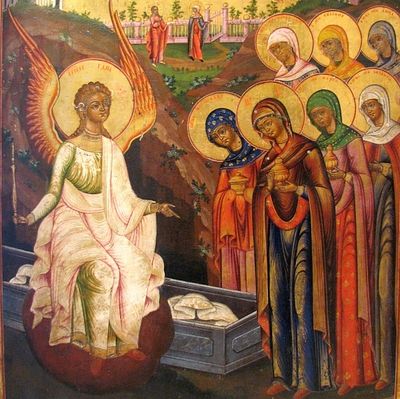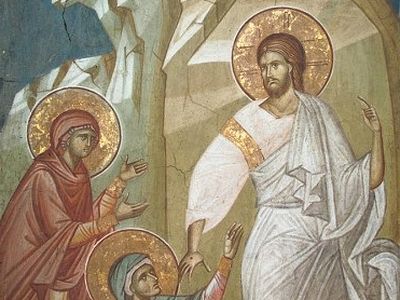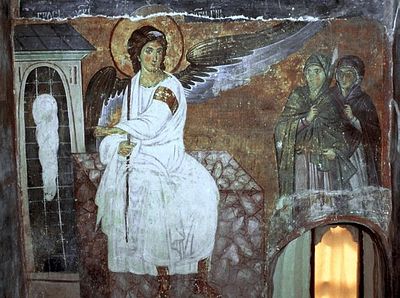Joseph of Arimathaea, an honourable counsellor, which also waited for the kingdom of God, came, and went in boldly unto Pilate, and craved the body of Jesus. And Pilate marvelled if he were already dead: and calling unto him the centurion, he asked him whether he had been any while dead. And when he knew it of the centurion, he gave the body to Joseph. And he bought fine linen, and took him down, and wrapped him in the linen, and laid him in a sepulchre which was hewn out of a rock, and rolled a stone unto the door of the sepulchre. And Mary Magdalene and Mary the mother of Joses beheld where he was laid. And when the sabbath was past, Mary Magdalene, and Mary the mother of James, and Salome, had bought sweet spices, that they might come and anoint him. And very early in the morning the first day of the week, they came unto the sepulchre at the rising of the sun. And they said among themselves, Who shall roll us away the stone from the door of the sepulchre? And when they looked, they saw that the stone was rolled away: for it was very great. And entering into the sepulchre, they saw a young man sitting on the right side, clothed in a long white garment; and they were affrighted. And he saith unto them, Be not affrighted: Ye seek Jesus of Nazareth, which was crucified: he is risen; he is not here: behold the place where they laid him. But go your way, tell his disciples and Peter that he goeth before you into Galilee: there shall ye see him, as he said unto you. And they went out quickly, and fled from the sepulchre; for they trembled and were amazed: neither said they any thing to any man; for they were afraid.
Mark 15:43-16:8
Because of the savour of thy good ointments thy name
is ointment
poured forth, therefore do the virgins love thee.
Song of Solomon 1:3
This Gospel passage makes us wonder and opens to us new dimensions for understanding the Resurrection in depth. The wondrous thing is that even though the myrrh-bearers came early in the morning to anoint the body of Jesus, they did not really anoint Him. The sweet savour of Christ (2 Cor. 2:14-17) has risen from the grave; He is risen; He is not here (Mk. 16:6).
The anointing of a dead man with myrrh was a loving act in order to compensate for the corrupted body. The Pharaohs thought about an illusory eternity for the body, when they anointed their dead. The Jews thought anointing gave honor to the dead. The real anointing is putting on incorruptibility. Christ rose from the grave, Himself being precious myrrh of sweet fragrance. Therefore, human nature carried this precious and new myrrh. The myrrh-bearing women did not anoint Jesus. After His Resurrection, the new myrrh-bearers, humanity, were given the opportunity to put on Christ, and not just to be anointed. In the Songs of Solomon, the Church cries out to the Lord, "Thy name is ointment." This ointment, this myrrh, becomes an anointing of every Christian by the rising of Christ from the grave. St. Nicolas Cabasilas wrote that after its fall, humanity built a wall of enmity and of separation between it and God. After the Resurrection of Christ, however, humanity put on glory and incorruptibility in Christ, and instead of the wall, anointing.
So the resurrection of Christ from the grave as new myrrh made the church a channel of ointment to all, and allowed every Christian to be a myrrh-bearer. The sacraments and rituals of the Church, and all Her life, is an anointing movement with this new myrrh of Christ. The Christian as a myrrh-bearer approaches not to anoint but to be anointed with the heavenly myrrh, so that He may die with Christ and rise with Him in His resurrection.
According to St. John of the Ladder, the secret of the new myrrh-bearers is that this new ointment reveals the identity of the bearers. They become themselves myrrh and sweet, not just in soul but also in body. The relics of saints that give forth myrrh are not rare cases in our Church.
The Church calls the Virgin Theotokos the precious myrrh. This new balm is the life of virtue, and the bearers of it are the men of prayer, and the soul that is full of virtues, purified from the old life of passions and corruption. As the Lord's name is ointment poured forth, the myrrh-bearers are the ones who carry this name. For all the saints were like Saint Paul who was not just living, but had Christ, the heavenly myrrh, living in Him.
The women myrrh-bearers went to the grave moved by their love towards the Lord, expressing their rejection of corruption. Their mission was realized in the Church where Christ, the myrrh of incorruptibility, is, and by whom we are anointed in the sacraments, carrying a life of virtue.
So let us put on Christ, being clothed with an incorruptible body for life eternal. Amen.






